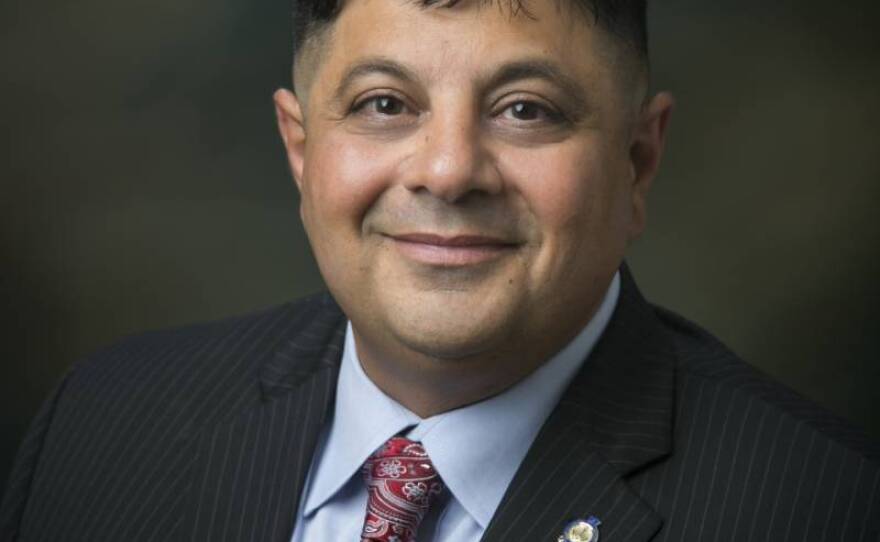In late March, Imperial County had just nine confirmed cases of COVID-19, and the head of the largest hospital there thought his community had dodged a bullet. But Dr. Adolphe Edward soon realized his assessment was premature.
“All of a sudden, we had 65 patients with COVID,” Edward recounted during a recent interview, “which was over 70 percent of my hospital admissions.”
Today, the rural county on the U.S.-Mexico border with 180,000 residents has the highest coronavirus infection rate per capita of any California county.
As of June 16, the county’s public health department reported that 4,389 people had tested positive, and 52 people had died with the virus.
Cross-Border Lives
The surge in cases is partly due to the county’s location right on the international boundary, health officials say. Edward’s hospital, the 150-bed El Centro Regional Medical Center, is just a half-hour drive north of Mexicali, a city with over a million residents in Baja California that has become the epicenter of the pandemic in Mexico.
Edward said he expected that when COVID-19 hit Mexicali hard, the sickness would hit his hospital too. And in fact, many of the patients seeking treatment at the medical center were U.S. citizens or legal U.S. residents who live in Mexicali, he said.
'Disease does not know borders, does not know boundaries. We’re really the community of Imperial County and Mexicali, and what happens over there comes to us, and what happens over here affects them.'
— Dr. Adolphe Edward, El Centro Regional Medical Center
“Disease does not know borders, does not know boundaries,” Edward said. “We’re really the community of Imperial County and Mexicali and what happens over there comes to us, and what happens over here affects them.”
Edward added that 60 of his employees live in Mexicali and commute across the border to work each day.
“I'm not sure if people are aware of just how common that is for us,” said Andrea Bowers, a spokeswoman for the Imperial County Public Health Department.
Thousands of people live on one side of the border and work or go to school on the other side, a practice that’s common in most border communities.
On Tuesday, the U.S. and Mexico extended until July 21, an agreement to restrict “non-essential” travel between the countries.
“I'm always afraid that people are imagining this rush on the border,” Bowers said. “It's just folks living their everyday life.”

Deaths Exceed Morgue Capacity
Although Imperial County is part of a binational region, the agricultural county has only two mortuaries. Only one, Frye Chapel and Mortuary, is taking the bodies of people who die with COVID-19. In addition, the county coroner’s office lacks a facility of its own and uses space at Frye for the county morgue.
Managing owner, Sheila Kruger, says the mortuary is holding more than double the number of decedents it had last year.
“I'm it,” Kruger said. “We are bursting at the seams, literally.”
With the mortuary handling all of the coronavirus funerals in the county, Kruger worries that the disease could keep spreading among the grieving families, who were often caring for their loved ones who died of the virus.
“These families that have been with the people that have COVID... they actually should be quarantined,” Kruger said. “[But] they come out here and try to make funeral arrangements.”
Kruger says she will now only make plans for services by phone or email. And she says funerals are restricted to ten people at a time inside the chapel.
“What people have been doing is they'll come in for a few minutes, and then they'll leave, and another set will come in,” Kruger said.
The ability for larger numbers of people to take turns paying their last respects means a lot to the families, she said, but it can increase the risk of infection because the funeral-goers typically will congregate in the parking lot.
“We've asked them to stay in their cars until it's time for them to come in, but they don't follow that,” said Kruger.
Large family gatherings are also a problem in other settings, according to Edward, the hospital director, who said coronavirus cases spiked about a week after two recent holidays.
“There were a lot of parties around Mother's Day. There's a lot of get-togethers on Memorial Day,” Edward said. “[And] I still see people out in the community that are not wearing their masks.”
Public health officials have warned residents against congregating, and they are issuing guidelines in English and Spanish urging people to wear masks and keep a safe distance from one another.
Baja officials are also urging residents to wipe their hands, disinfect, and always wear masks in public.
The Baja California government website reported 3,826 confirmed cases of COVID-19 in Mexicali, as of Tuesday. That’s fewer than the number of cases in Imperial County. However, Mexicali had 664 reported deaths from COVID-19, and health services there have been strained.
Imperial County Wants More Control Over Safe Reopening
Imperial is one of six counties in California that had not yet received state approval for advanced stage 2 reopening. It’s one of 11 counties on a state monitoring list for “targeted engagement” from the California Department of Public Health.
'Employees are starting to say we want to work. Bills are stacking up.'
— Luis Plancarte, Chairman Imperial County Board of Supervisors
Imperial County is experiencing elevated disease transmission,” according to the department’s website. “Drivers of this include U.S. citizens coming across the Mexican border seeking healthcare and continued need for staffing solutions at hospitals.”
Despite the high caseload, the Imperial County Board of Supervisors wrote to Gov. Gavin Newsom June 3 requesting that the state give the county’s health officer discretion over how and when to reopen parts of the economy.

Imperial County has a high rate of poverty and unemployment. According to 2018 U.S. Census data, 21% of county residents lived in poverty compared with 13 % statewide average, and the median household income was $46,000 compared to the state median of $71,000.
“Employees are starting to say we want to work,” Chairman Luis Plancarte said on a recent press call. “Bills are stacking up.”
The board wants to reopen restaurants and retail stores to get the economy rolling again and says small businesses are committed to doing so safely.
County officials said Tuesday they will meet with leaders in the California Department of Public Health on Thursday to discuss the request.
In the meantime, state health officials have stepped in to help supplement local medical resources — sending teams of doctors and nurses.
Since April 1, hospitals around California have accepted 300 patients from Imperial County who need higher levels of care. The state helped airlift them to hospitals in neighboring San Diego and Riverside counties and as far north as Santa Clara and San Mateo counties.
Edward said the assistance is giving his staff a much-needed breather.
“We’re nonstop,” he said. “There is no Friday. There's no Saturday. There's no Sunday.”






